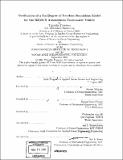Verification of a six-degree of freedom simulation model for the REMUS autonomous underwater vehicle
Author(s)
Prestero, Timothy (Timothy Jason), 1970-
DownloadFull printable version (10.18Mb)
Alternative title
Verification of a 6-degree of freedom simulation model for the REMUS AUV
Other Contributors
Woods Hole Oceanographic Institution.
Advisor
Jerome Milgram, Kamal Youcef-Toumi and Christopher von Alt.
Terms of use
Metadata
Show full item recordAbstract
mproving the performance of modular, low-cost autonomous underwater vehicles (AUVs) in such applications as long-range oceanographic survey, autonomous docking, and shallow-water mine countermeasures requires improving the vehicles' maneuvering precision and battery life. These goals can be achieved through the improvement of the vehicle control system. A vehicle dynamics model based on a combination of theory and empirical data would provide an efficient platform for vehicle control system development, and an alternative to the typical trial-and-error method of vehicle control system field tuning. As there exists no standard procedure for vehicle modeling in industry, the simulation of each vehicle system represents a new challenge. Developed by von Alt and associates at the Woods Hole Oceanographic Institute, the REMUS AUV is a small, low-cost platform serving in a range of oceanographic applications. This thesis describes the development and verification of a six degree of freedom, non-linear simulation model for the REMUS vehicle, the first such model for this platform. In this model, the external forces and moments resulting from hydrostatics, hydrodynamic lift and drag, added mass, and the control inputs of the vehicle propeller and fins are all defined in terms of vehicle coefficients. This thesis describes the derivation of these coefficients in detail. The equations determining the coefficients, as well as those describing the vehicle rigid-body dynamics, are left in non-linear form to better simulate the inherently non-linear behavior of the vehicle. Simulation of the vehicle motion is achieved through numeric integration of the equations of motion. The simulator output is then checked against vehicle dynamics data collected in experiments performed at sea. The simulator is shown to accurately model the motion of the vehicle.
Description
Thesis (S.M.)--Joint Program in Applied Ocean Science and Engineering (Massachusetts Institute of Technology, Dept. of Ocean Engineering; and the Woods Hole Oceanographic Institution); and, (S.M.)--Joint Program in Applied Ocean Science and Engineering (Massachusetts Institute of Technology, Dept. of Mechanical Engineering; and the Woods Hole Oceanographic Institution), 2001. Includes bibliographical references (p. 125-127).
Date issued
2001Department
Joint Program in Applied Ocean Physics and Engineering; Woods Hole Oceanographic Institution; Massachusetts Institute of Technology. Department of Mechanical Engineering; Massachusetts Institute of Technology. Department of Ocean EngineeringPublisher
Massachusetts Institute of Technology
Keywords
Joint Program in Applied Ocean Science and Engineering., Ocean Engineering., Mechanical Engineering., Woods Hole Oceanographic Institution.